


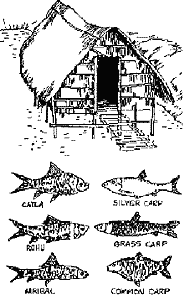 |
Chicken raising for meat (broilers) or eggs (layers) can be integrated with fish culture to reduce costs on fertilizers and feeds in fish culture and maximize benefits. Chicken can be raised over or adjacent to the ponds and the poultry excreta recycled to fertilize the fishponds. Raising chickens over the pond has certain advantages: it maximizes the use of space; saves labour in transporting manure to the ponds and the poultry house is more hygienic. No significant differences have been observed on the chickens' growth or egg laying when they are raised over the ponds or on land. In case of the former, the pond embankment could still be utilized for raising vegetables.
1. Pond preparation
2. Stocking
3. Feeding
4. Fertilization
5. Harvesting
6. Oxygen depletion
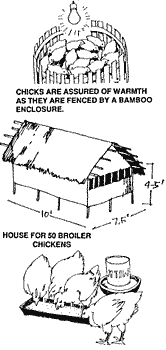 |
For the first 14 days, chicks need to be raised separately in a brooder (not on pond), as they need higher temperature of 28-33 ºC (85-95 ºF). Each chick during this period needs a space of 7.5 x 7.5 cm (9 in²). To maintain the required temperature range, surround the chicks in a bamboo fence and hang an electric or kerosene lamp above them. A rice husk heater can also be used.
1. Broilers: 30-50 broilers could be raised on a 1 000 m² pond.
2. Chicken layers: 30-50 layers can be raised over a pond of 1 000 m².
Feed composition for layers
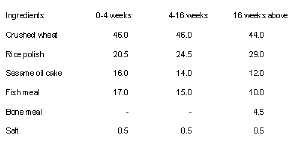
Vitamins premix at 250 g/100 kg feed.
Vaccinate your chickens
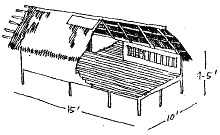 |
In some countries, vaccines can be obtained from the nearest livestock office, free of cost. The following are some reminders when collecting vaccines:
Equipment necessary in vaccination
Reminders when vaccinating chickens
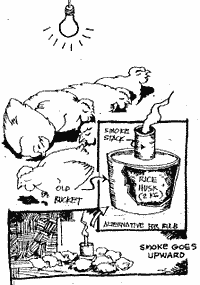 |
Budget (in taka ) for a 1 000 m² pond in integrated
|
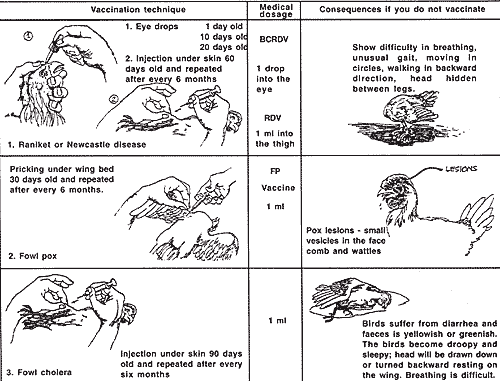 |
- Chicken shed: TK5 000; life expectancy, 3 years
- Feeder and waterer: TK200; life expectancy, 4 years
Budget (in taka) for a 1 000 m² pond in integrated
chicken-fish farming with 50 layers over an 18-month period
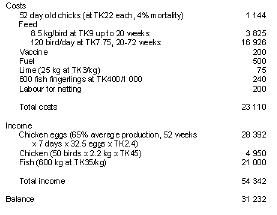
Issues for further consideration The case presented is a resource-intensive experimental system. Most farmers may find it difficult to sustain the 30-50 birds that are recommended. This activity may be adopted by somewhat «better off» farmers with an entrepreneurial focus. Identifying who adopted this in existing communities and who could be potential adopters in other communities could be done through ranking exercises. Although the importance of chicken diseases is emphasized in the example, most resource-poor farmers are at least equally constrained by the lack of, or poor quality of existing, chicken feed. In implementing the technology, more information will be required on what proportion of the feed can be produced by the farm household, or is produced and purchased locally, or needs to be supplied from outside the village (e.g. fishmeal, bonemeal, salt, vitamins). Also, information on who carries out the activities and who benefits within the household will be useful for planning. From experience with this technology in field trials, the poultry component was the problematic part. It required a higher level of investment and managerial skill. Uneconomical scales of chicken farming operations limited acceptance by farmers and caused the few adopters to terminate the activities. Limited levels of integration can be achieved with backyard chicken rearing. Farmers usually rear few birds (usually only 5-10) and let them roam freely, avoiding the need for purchasing feed. Any development of a new vaccination program in a particular area would need to take the experience of farmers and the local livestock office on the most important diseases in the region into account. In addition to the preventive vaccination the need for curative treatment, e.g. of parasitic diseases may arise. The procedure for vaccination (amount, mode of application etc.) may vary between different brands, and in this respect the guidelines given by the vaccine producer should allways be followed. Tap water containing chlorine can inactivate the live vaccines (but boiling it for 15 minutes will remove most of the chlorine). In addition to being stored cool, the vaccines should also be kept away from direct sunlight. Soap must be completely rinsed off the equipment as it might inactivate the live vaccines. Also, in many countries the legislation prohibits others than veterinarians to use injectable vaccines. Regarding the chicken house, the 1 cm gap in between the slats of the floor is likely to be too big for 14 days old chicks so they may hurt themselves. The solution could either be to reduce the spacing or to keep the chicks for a longer time in the brooder. |